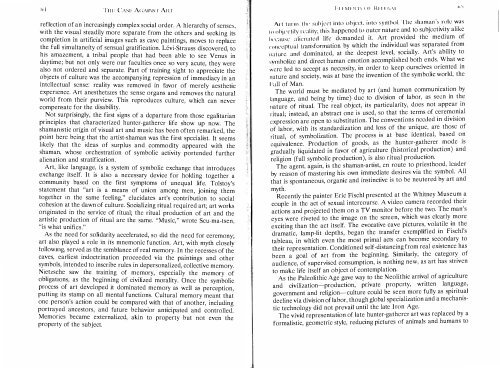CONTENTS - ouroboros ponderosa
CONTENTS - ouroboros ponderosa
CONTENTS - ouroboros ponderosa
You also want an ePaper? Increase the reach of your titles
YUMPU automatically turns print PDFs into web optimized ePapers that Google loves.
'1'111 CASI'. ;\"AINSI ;\1{1<br />
reflection of an incrcsingly complex social order. A hierarchy of senses,<br />
wIth the vIsual steadIly more separate from the others and seeking its<br />
completIOn m artrflclal Images such as cave paintings, moves to replace<br />
the full sImultaneIty of sensual gratification. Levi-Strauss discovered, to<br />
hIs amazement, a tnbal people that had been able to see Venus in<br />
daytime; but not only were our faculties once so very acute, they were<br />
also not ordered and separate. Part of training sight to appreciate the<br />
?bJects of culture was the accompanying repression of immediacy in an<br />
mtellectual sense: reahty was removed in favor of merely aesthetic<br />
expenenee. Art anesthellzes the sense organs and removes the natural<br />
world from their purview. This reproduces culture, which can never<br />
compensate for the disability.<br />
Not surprisingly, the first signs of a departure from those egalitarian<br />
prIncIples . that characterized hunter-gathercr life show up now. The<br />
shamamstlc ongm of VIsual art and music has been often remarked the<br />
point here being that the artist-shaman was the first specialist. It sems<br />
likely that the ideas of surplus and commodity appeared with the<br />
shaman, whose orchestration of symbolic activity portended further<br />
alIenation and stratification.<br />
Art, like language, is a system of symbolic exchange that introduces<br />
exchange itself. It is also a necessary device for holding together a<br />
commumty based on the first symptoms of unequal life. Tolstoy's<br />
statcment that "art is a means of union among men, joining them<br />
together III the same feeling," elucidates art's contribution to social<br />
cohesion at the dawn of culture. Socializing ritual required art; art works<br />
ongmated m the service of ritual; the ritual production of art and the<br />
artistic production of ritual are the same. "Music " wrote Scu-ma-tsen<br />
"is what unifies."<br />
As the need for solidarity accelerated, so did the need for ceremony;<br />
art also played a role m Its mnemonic function. Art, with myth closelv<br />
followlllg, served as the semblance of real memory. In the recesses of th<br />
caves, earliest indoctrination proceeded via the paintings and other<br />
symbols, intended to inscribe rules in depersonalized, collective memory.<br />
Nietzsche saw the trammg of memory, especially the memory of<br />
obhgatlOns, as the beginning of civilized morality. Once thc symbolic<br />
process of art developed It dominated memory as well as perception,<br />
puttlllg Its stamp on all mental functions. Cultural memory meant that<br />
onc person's action could be compared with that of another, including<br />
portrayed ancestors, and future behavior anticipated and controlled.<br />
Memones became externalized, akin to property but not even the<br />
property of the subject.<br />
"<br />
1 1 1'1\11'1'4 I" ( )), 1{1'1 11" .. \1<br />
Art turns till' suhject into ohject, illto symbol. The shaman 's role was<br />
[I> I>hilTlily rl'alily; I his happened to outer nature and to suhjeetivity alikc<br />
kcallsc alienall:d life demanded it. Art provided the medium of<br />
cl>nceptllal transformation by which the individual was separated from<br />
"alure and dominated, at the deepest level, socially. Art's ability to<br />
svmholize and direct human emotion accomplished both ends. What we<br />
were led to accept as necessity, in order to keep ourselves oriented in<br />
nature and society, was at base thc invention of the symbolic world, the<br />
hill of Man.<br />
The world must be mcdiated by art (and human communication by<br />
language, and being by time) duc to division of labor, as seen in the<br />
nature of ritual. The real object, its particularity, does not appear in<br />
ritual; instead, an abstract one is used, so that the terms of ceremonial<br />
expression are open to substitution. The conventions neetled in division<br />
of labor, with its standardization and loss of the uniquc, are thosc of<br />
ritual, of symbolization. Thc process is at base identical, based on<br />
equivalence. Production of goods, as the hunter-gatherer modc is<br />
gradually liquidated in favor of agriculture (historical production) and<br />
religion (full symbolic production), is also ritual production.<br />
The agent, again, is thc sbaman-artist, en route to priesthood, leader<br />
by reason of mastering his own immediate desires via the symbol. All<br />
that is spontaneous, organic and instinctive is to be neutered by art and<br />
myth.<br />
Recently the painter Eric Fischl prescnted at the Whitney Museum a<br />
couple in the act of sexual intercourse. A video camera recorded their<br />
actions and projected them on a TV monitor before the two. The man's<br />
eyes were riveted to the image on the screen, which was clearly more<br />
exciting than the act itself. The evocative cave pictures, volatile in the<br />
dramatic, lamp-lit depths, began the transfer exemplified in Fischl's<br />
tableau, in which even the most primal acts can become secondary to<br />
their representation. Conditioned self-distancing from real existence has<br />
been a goal of art from the beginning. Similarly, the category of<br />
audience, of supervised consumption, is nothing new, as art has striven<br />
to make life itself an object of contcmplation.<br />
As the Paleolithic Age gave way to the Neolithic arrival of agriculture<br />
and civilization-production, private property, written language,<br />
government and religion-culture could be seen morc fully as spiritual<br />
decline via division of labor, though global specialization and a mechanis<br />
tic technology did not prevail until the late Iron Age.<br />
The vivid representation of late hunter-gatherer art was replaced by a<br />
formalistic, geometric style, reducing pictures of animals and humans to<br />
j)'-,






